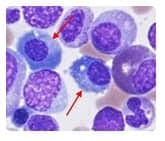Exam Details
Exam Code
:ASCP-MLTExam Name
:MEDICAL LABORATORY TECHNICIAN - MLT(ASCP)Certification
:ASCP CertificationsVendor
:ASCPTotal Questions
:572 Q&AsLast Updated
:Mar 29, 2025
ASCP ASCP Certifications ASCP-MLT Questions & Answers
-
Question 101:
Specimens collected from patients in contact isolation should be:
A. Collected in duplicate.
B. double-bagged.
C. delivered to microbiology.
D. collected wearing sterile gloves.
-
Question 102:
HbA1C is the recommended test for monitoring diabetic carbohydrate management. Microalbuminuria, low concentrations of urinary albumin, is measured to detect early renal impairment, at a stage where it is reversible with treatment. What is the role of microalbuminuria testing?
A. Monitor diabetic patient carbohydrate management
B. Detect small-sized urinary albumin molecules in early renal disease
C. Detect small urinary concentrations of albumin before there is irreparable renal damage
D. Diagnose renal failure in a type 1 diabetic patient
-
Question 103:
What is the CORRECT blood-to-anticoagulant ratio for coagulations tests?
A. 4:1
B. 5:1
C. 9:1
D. 10:1
-
Question 104:
The correct answer which best fits the characteristics in this question is Mycobacterium kansasii.
The remaining Mycobacterium strains can be elimated as:
Mycobacterium marinum is considered a fast-grower.
Mycobacterium scrofulaceum produce deep-yellow to orange pigmented colonies when grown in the either the light or dark.
Mycobacterium avium grows colonies which are nonpigmented in the light and dark which do not intensify after light exposure.
What is the MOST likely identification of an acid-fast bacillus that demonstrates the following characteristics?
slow growth
cream to tan colored colonies when grown in the dark
development of yellow pigment upon exposure to light
A. Mycobacterium kansasii
B. Mycobacterium marinum
C. Mycobacterium avium
D. Mycobacterium scrofulaceum
-
Question 105:
The ApoB/ApoA1 ratio has a positive risk marker (ApoB-100) and a negative risk marker (ApoA1). Risk diminishes as ApoA1 goes up (a negative marker) and risk increases in proportion to ApoB concentrations (a positive risk marker). This 'double-edged sword' provides good risk prediction. The other risk markers in question do not have this dual- advantage.
Which risk marker has both positive and negative cardiovascular risk integrated into its measurement?
A. LpPLA2
B. Oxidized LDL
C. ApoB/ApoA1
D. hs-CRP
-
Question 106:
Either immunofixation or immunoelectrophoresis can be used to confirm Bence-Jones proteinuria.
Which of the following methods would be used to confirm the presence of Bence-Jones protein in the urine:
A. Urine protein electrophoresis
B. Sulfosalicylic acid
C. Isoelectric focusing
D. Immunofixation
-
Question 107:
The cells are plasma cells. They are larger than normal small lymphocytes with more abundant cytoplasm. The cytoplasm is more basophilic than the cytoplasm of a normal lymphocyte and a well-defined perinuclear halo (clearing in the golgi area) is noticeable. The nucleus is eccentrically placed. Plasma cells are counted in a separate category on a bone marrow differential.

Hematogones are blast-like cells that are more mature than lymphoblasts. They are usually tallied with lymphocytes when performing a bone marrow differential. What are the cells that are indicated by the red arrows in the image on the right?
A. Normal lymphocytes
B. Hematogones
C. Plasma cells
-
Question 108:
The proper pH for a unit of platelets must be above 6.2. According to the FDA, accurate pH measurement is time dependent, and samples should be tested within 1 hour of sampling, or as suggested by the manufacturer of the pH measurement system. It is recommended that a pH meter or gas analyzer be routinely used rather than pH (nitrazine) paper. However, if the laboratory chooses to determine pH measurements with nitrazine paper, the selected paper should read in increments of one-tenth units, or it may provide inaccurate measurements. Maintaining proper pH requires at least 35 ml, but preferably 50- 70 ml of plasma per platelet unit.
In order to prevent a loss of viability in platelet concentrates during storage the pH must be maintained above:
A. 7.5
B. 6.2
C. 5.0
D. 4.5
-
Question 109:
A. 3.79 liters
B. 1 liter
C. 2.5 liters
D. 4.2 liters
-
Question 110:
Following an AMI, elevated CK-MB returns to normal ranges in 48-72 hours. If a patient has a second AMI in this time period, a second rise in concentrations of CK-MB would be seen. This is not true for the cardiac troponins since they remain elevated 7-14 days following an AMI.
Which one of the following cardiac biomarkers could detect a reinfarction?
A. cTnI
B. cTnT
C. TnC
D. CK-MB
Related Exams:
Tips on How to Prepare for the Exams
Nowadays, the certification exams become more and more important and required by more and more enterprises when applying for a job. But how to prepare for the exam effectively? How to prepare for the exam in a short time with less efforts? How to get a ideal result and how to find the most reliable resources? Here on Vcedump.com, you will find all the answers. Vcedump.com provide not only ASCP exam questions, answers and explanations but also complete assistance on your exam preparation and certification application. If you are confused on your ASCP-MLT exam preparations and ASCP certification application, do not hesitate to visit our Vcedump.com to find your solutions here.